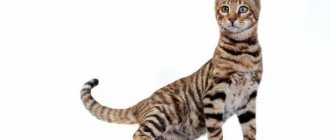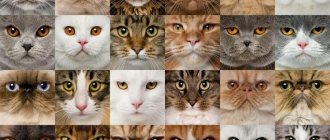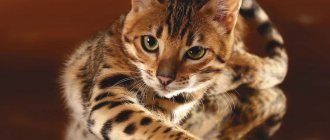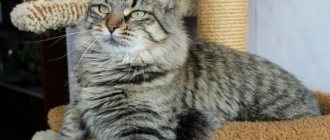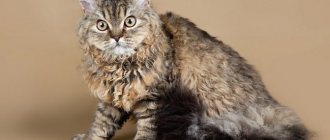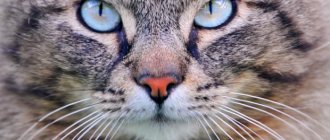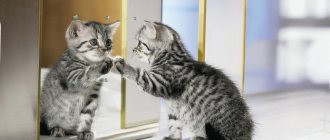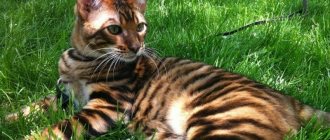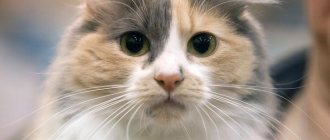Gray cats have always been the center of attention, and their silver-blue coat has long been associated with moonlight and was considered a sign of aristocracy. And today, animals with a smoky color are recognized as the personification of internal harmony and emotional stability. It is not surprising that they are in great demand among ordinary owners and professional breeders.
Let's find out which cat breeds are characterized by gray fur.
Popular breeds
There are breeds whose representatives can only be gray, others allow a wide variety of colors, but it is the gray color that is considered one of the most expressive. Next, we invite you to consider photos and descriptions of the most popular gray cats.
- Russian blue. The birthplace of this breed is Russia and initially it existed only on the territory of this country. In the 18th century, blue cats were exported to England, and a little later they spread throughout Europe. According to the breed standard, such a pet can have only one color - noble blue. At the same time, the wool itself is very soft, dense and thick. The animal is characterized by a harmonious build, graceful gait and a very flexible tail. Gray cats of this breed are easy to breed and are distinguished by good health. However, they can only be bred within the breed.
- Siberian cat. For her, gray is not the only color, but it is in it that she looks the most original. The Siberian gray cat looks majestic, and in all possible variations of this shade. But the most incredible color among others is SOLID BLUE. In this case, the animal’s fur can have any shades of blue: from very light to dark. But the tone must be uniform on all parts of the body, and the nose and paw pads must be blue. Shading, when the ends of the hair are colored more intensely than the roots, is considered a defect.
- Scottish fold. These cats are known for their folded ears that do not extend beyond the contour of the head, making it appear even rounder, and the face is very cute. For fold-eared cats, gray coat color is also not the main color, but at the same time it is the most widespread. The color can be rich blue, warm lilac, lilac-gray, and silver-gray tabby is not uncommon. But if we talk specifically about the blue color, then it, like other breeds, must certainly be uniform. The paw pads and nose are blue-gray with a blue coat.
- British. It is believed that gray color is most typical for cats of the British breed. Their fur with this color shimmers with bluish colors and can be either very light or interspersed with dark gray hairs. Often there are blue-gray British cats whose fur is dyed as evenly as possible, making these cats look more like teddy bears than living pets. Eyes with a gray-blue coat can be either green or orange. And we all, of course, remember the famous gray tabby cat from the Whiskas advertisement. He also belongs to the British breed, and his color (merle tabby) is one of the most popular and sought after.
- Persians. The Persian gray cat can have either a uniform tone throughout its luxurious coat or its smoky variations, including blue ones. Moreover, representatives of this breed are called the only ones who can “try on” a huge range of gray tones. Among Persians, silver-marbled cats with a “butterfly” on their shoulders, and silver-lilac, and silver-blue, and silver-chocolate, etc. are common. The color of the eyes will depend on the color and can be green, honey and blue-green.
- Ojos azules. Absolutely all colors are allowed for representatives of this breed; the only thing undesirable is a large number of white spots. The calling card of such cats is their eye color – bright blue. Therefore, no other breed is capable of bringing into the world such a miracle as a gray cat with blue eyes.
Thai Ridgeback
Dogs used to be almost unknown outside their homeland. The national history of Thailand is inextricably linked with this breed. Its images are found in rock paintings, and the first mentions in manuscripts date back to the 17th century. Due to the long-term isolation of the country from the main continent, the dog was not crossed; it remains pristine and belongs to the indigenous breeds. The blue color of the animal's fur is very rare. When new generations were bred, her black coat, the hairs of which were visible among the main one, degenerated. The wool is very soft, like velvet. This is a very smart dog, characterized by affection for its owner. It is noteworthy that Thai Ridgebacks speak very rarely, although it is distinguished by its extraordinary velvety quality.
Russian blue
What breeds of gray cats are there? The name of some speaks for itself. For example, when you hear “Russian blue cat,” you can roughly imagine what kind of purr it is. If you still don’t know her, then now let’s talk about this mustachioed one. This is an intelligent, gentle, attentive and devoted cat, with a beautiful quiet voice. She has a long tail, neck, elongated body. The color is blue (uniform) with a silver tint. At first, she is distrustful of new acquaintances. This cat does not like to change its habitat and prefers routine. She is affectionate and playful with her owners; unfortunately, she does not establish close relationships with owners very quickly. Over time, he becomes a devoted friend.
Did you like this breed of gray cat? You can see a photo of the representative in our article. You can take a closer look at its appearance.
Who suits blue hair
Blue hair color will suit many people, there are no special restrictions. The color is ideal for natural blondes with light eyes and fair skin.
There are warnings only if you have frequent rashes on your face and blue discoloration under your eyes. Otherwise, the blue will give a pale appearance.
@hairbyveronicarose
@aestheticl0ver
Breeds for which only gray coat color is acceptable
Among the varieties of cats, there are those that are characterized only by an ash-colored coat. These breeds include:
- ;
- chartreuse;
- Nibelung;
- korat
Russian blue
Representatives of this breed are medium in size and have a slender build. But the main feature of Russian blue cats is considered to be their unique color, emphasizing the bright green color of their eyes. Their coat has silver ticking, which gives their short, thick coat a snowy effect.
According to the standard, a Russian Blue cat must have uniform fur without yellowness, streaks or inclusions.
Chartreuse
These are large, well-built cats with well-developed muscles, a cheeky muzzle, a round head and small ears. Their soft, plush coat with a thick undercoat is colored only a uniform gray.
Blue cats' irises can be dark orange or bright yellow. And each chartreuse paw has soft gray-blue pads.
Nibelung
This is a long-haired variety of Russian Blue cats that has inherited all the characteristics of its ancestors with the exception of the structure and length of the fur. The Nibelungs got their name (translated from German as “creature of fog”) due to the unique color of their fur coat.
The thin silky coat of the breed is colored blue, in harmony with the green eyes. According to the standard, these gray cats have weak ticking.
Korat
These elegant gray cats were brought to Europe from northern Thailand over a hundred years ago and were long considered a cull of the Siamese. Korats are medium in size, flexible muscles and have an unusual heart-shaped head.
Top articles: How different animal populations interact
The hallmark of the breed is its olive-green eyes and short, silky coat, the color of which varies from blue-gray to lavender.
Italian Greyhound
Starting from the 16th century, there are references to a small greyhound. This is a very graceful, intelligent animal. When permanently living in the rooms, it leaves almost no odors. It has thin, short hair that fits tightly to the body. He gets used to it very quickly and is sensitive to his owner. Loves to walk, but does not tolerate rainy weather.
Among dogs with a blue color there are both hunting and indoor specimens, guard dogs, and sports dogs. Regardless of their purpose, animals need care and attention. For this they pay the owner with loyalty and love.
- Author: Elena Romanenko
Rate this article:
- 5
- 4
- 3
- 2
- 1
(8 votes, average: 3.8 out of 5)
Share with your friends!
Caring for gray cats
Gray cats
, both blacks and tabbies are enviably healthy. They have strong immunity and are very cold-resistant. But there is one thing: color. Show cats have to limit themselves in many ways in order to shine with the ideal ash shade of their coat. Direct sunlight, excessive humidity, the presence of a large amount of iodine in food - all this leads to the appearance of yellowish spots on the coat, and as a result, underestimates the assessment of beauty according to breed standards.
A gray cat is not suitable for every owner. For example, children may find it boring and uninteresting. She is calm and balanced. You can't make her run for hours after a toy or jump from chair to chair. She has a special temperament and noble manners. The mysticism running through the history of its origin prophesies female happiness. Maybe a gray cat
can really give a strong family and love to those who really need it? As history has shown, on the “ashes” of her wool you still manage to build your own warm and cozy hearth, or at least place warmth in your heart.
How blue Bengals appear
The color gene responsible for the birth of a blue Bengal kitten is known as recessive. That is, it can be carried by any color, different types of patterns - a pair of Bengals without signs of blue in their fur may have smoky blue kittens. They will also recessively carry the “blue gene”, but it will not necessarily appear in the coming generations. However, in cases where a blue female is offered the same male for mating, the likelihood of the desired elite coloring in the offspring increases.
Breeders who have extensive experience working with blue Bengals have discovered an interesting pattern: when working with a recessive gene, other “non-major” genes often become dominant - for example, large spots, special softness of the coat, its shine. This is one of the reasons why Blue Bengals are quickly gaining popularity among professional breeders.
Unexpected results from the blue gene (blue is often considered a diluted color form of traditional brown shades) have given rise to a number of varieties. Experts already distinguish such types as spotted and marbled blue lynx, blue mink, blue sepia - spotted or marbled.
How to care?
Caring for gray-white cats is not much different from caring for animals whose fur has other shades. However, there are still some characteristic features.
So, in the process of keeping an animal, as well as caring for it, one should take into account all the features of the breed that are characteristic of this animal
Particular attention should be paid to the behavioral patterns of cats.
In addition, as a general rule, when eating, you should avoid including animal products rich in iodine in your diet. The thing is that a high content of this component in the animal’s body can affect its appearance in such a way that the gray-white wool will have a brownish tint. If you want to preserve the original purity of the color, then this rule should in no case be neglected.
The diet must be saturated with all microelements and substances that are necessary for the full growth and development of the animal. It doesn’t matter whether you prefer dry food or natural food.
Due to the light color of the coat, grooming measures for it deserve special attention. Gray-white cats need bathing and hygiene procedures more often than other cats. This is especially true for those animals that spend a lot of time outside (for example, if you live in a private house and let your cat out into the yard). Combing procedures are also necessary, the regularity of which depends on the length of the fur of a particular animal.
Of course, to keep a cat at home, it must be provided with all the necessary equipment: a tray that acts as a toilet, its own bed, bowls of food and water, and a scratching post. Try to create the most comfortable and convenient conditions for the cat, because in your apartment he should feel at home, and not as a guest.
Despite the fact that all of the above aspects of cat care and maintenance are very important, the basic and basic principle of keeping a pet is still constant monitoring of its health. In order to maintain the animal's health at the proper level, from the very first day of keeping him, make sure that he has received all vaccinations and other necessary medical procedures. Do not forget about regular systematic visits to the veterinarian to treat the animal for fleas, worms and other harmful organisms.
Thus, you and I were able to see that in nature there are a huge number of species and breeds of gray-white cats. Some are more valuable and cost more than others. Despite this, there is no doubt that regardless of breed or lack thereof, the gray and white color attracts many
It is important to remember that the physiological and psychological characteristics of a particular animal will depend more on its breed, and not on its color. Therefore, before buying a pet, carefully study the characteristic features of cats of the exact type you plan to have at home.
About the Siberian breed of gray cats, see the video below.
Kerry Blue Terrier
Dogs of this breed were also bred in Ireland at the beginning of the 19th century by crossing an Irish terrier with a wolfhound. At the same time, we managed to improve the flair and preserve the original color. The animal was used to guard the house and hunt foxes and game birds. There is information that it also served as a herding dog. The main decoration of the breed is its thick, soft, wavy coat. He loves movement and running. Timely training of a pet is of great importance. If training is not started at an early age, the dog becomes aggressive.
Description of the breed
Persian standard
There are currently 4 main types of Persian cats recognized:
- The classic type (British) is outdated, with a noticeable nose, the edge of which is located 5-6 mm below the edge of the inner corner of the eye.
- Modern type (short nose) - have an open look, the bridge of the nose is raised. Thanks to the wide eyes, the nasolacrimal ducts are not deformed, and the animal does not have a gloomy expression on its face.
- Extreme type (American) - the breed description is characterized by a short nose, round forehead, low-set ears, and straight-set eyes. The earlobe is almost at the same level with the inner corner of the eyes.
- Pig type (piggy) - the convexity of the skull is almost not pronounced, low weight, weak bones. This type is derived from the extreme.
Regardless of the type, the following reference characteristics are distinguished:
- Body: massive but compact; the chest and stomach are wide, rounded; the tail is proportionally short, very fluffy; average weight for females is 3-4 kg, for males 5-6 kg.
- Coat: silky, soft long hair covering the entire body; There are more than 200 species of Persian cat colors, including the graceful white Persian chinchilla.
- Head: muzzle flattened, almost flat, bone wide; forehead is rounded; the nose is short and raised.
- Eyes: wide-set, large and expressive; eye color can be green, blue, brown, and can also differ from one another (colorpoints with blue eyes and chinchillas with green should be noted separately); friendly look.
- Ears: usually small, low set, rounded tips; hidden behind abundant fur.
- Limbs: paws are fluffy, thick, proportionally short relative to the body.
- Life expectancy: extreme Persians live up to 15 years, ordinary modern Persians under normal conditions can live on average up to 20 years.
Best articles: Why are cats afraid of water? How to wash a cat if it doesn't like water?
Colors
- Solid (solid) - solid colors: white, black, blue, red (red), lilac, cream, chocolate. There are no patterns or streaks on the wool. Eye color is most often copper and dark orange or dark blue in white Persians.
- Bicolor is a combination of a primary color and white. The color of Persians is rare for Russian exhibitions, since breeding such a capricious spotted color requires a lot of effort. Bicolors should have at least 1/2 and no more than 2/3 white in color, with white spots on the head and tail desirable.
- Tabby - patterns on the fur: stripes, spots and marbles. Any basic coat color.
- Color point is the so-called Siamese coat color with dark spots on the face, paws and tail. Popular colors include brown, lilac, blue and black spots. Persian color-pointed cats were even identified as a separate breed - the Himalayan cat.
- Smoky is an amazing color in which each hair is conventionally divided into 2 color parts: a light base at the root and a dark color at the tip - tipping. At rest, the cat appears monochromatic, but when moving, the light undercoat becomes visible. Shades: black smoky, blue smoke, chocolate, tortoiseshell, lilac.
- Chinchilla - Golden and silver Persian chinchillas are now considered very popular and popular colors of the breed. Black tipping (the hair is colored only 1/8 with a dark tip) is evenly distributed on the back, sides, head and tail. The main color of gold is light apricot, while that of silver is pure white. A characteristic feature of chinchillas is the black rim around the eyes, nose and lips.
- Tortoiseshell is the color of Persian cats, in which there is a combination of two primary colors at once - red and black or their lightened analogues - cream and blue. This also includes the calico color - a combination of tortoiseshell and white.
Phasing in kittens from a litter of blue Bengal cats
Temporary thin hair was “invented” by nature as a means of camouflaging the baby until he grew up and became stronger. Bright spots will betray a helpless kitten to another predator - therefore, long, thin, light hairs cover the pattern until a certain age. The lighter the base background and the shorter the coat, the less susceptible a Bengal child is to phasing. As they grow older, the shade of the coat often becomes more intense, and the contrast of the pattern is maintained or appears more clearly.
In some cases, kittens come into the world already with phasing. Usually these camouflage hairs fall out after 2 weeks, but can then grow back. Bengals are finally freed from the fur covering their texture by the age of six months or a couple of months earlier or later. As a result, a blue Bengal cat already at junior age has a festive light-colored, spectacular coat.
The Blue Bengal, while not recognized in the UK, can be shown at Tica events under a new trait division. However, unfortunately, it cannot achieve champion status, like a number of other new colors of Bengal cats.
Smoky blue hair is the rarest subspecies of the Bengal cat's coat color. It is officially registered only by a few international associations and only recently. If the birth of the Bengal breed is the second half of the 20th century, then the blue Bengal is already the 21st century. Such colors appear in litters so far rather as an exception. Felinologists and breeders distinguish them from the silver color by a soft, smoky coat with obvious bluish metallic tints on the coat, on which, with age, sometimes not immediately noticeable gray-bluish spots of irregular, but mostly round shapes or streaks appear. Many cat lovers, when they see blue Bengals for the first time, find that they are very distinctive.
Gray cat breeds
The elegant gray color of the cat's fur (aka blue) speaks volumes about the “breed” at first glance. These cats are nicknamed blue because of their unusual iridescence, which can sometimes be seen under direct light. Depending on the darkness of the color, blue and blue cats are distinguished. Since ancient times, the color blue has been associated with spirituality, wisdom and was endowed with special mystical properties. Therefore, cats with such an unusual color were also attributed the above qualities. Moreover, it was believed that a blue cat could predict bad weather and protect the family hearth from dark forces.
The subtle aesthetic of gray is also associated with the moon. This gives the animal a special mysticism and grace. Gray cats
recognized as one of the most elegant and aristocratic.
Many believe that the appearance of such an exquisite animal in the house will bring harmony to relationships and give the eyes pleasure from beauty. The moon symbolizes the feminine principle. Therefore, a gray cat will get along well with a representative of the fair sex and will have a beneficial effect on her nervous system and reproductive function. It was believed that a gray cat
could become a real guardian angel for a child in the womb.
